
Guanacaste is a province of Costa Rica located in the northwestern region of the country, along the coast of the Pacific Ocean. It is bordered by Nicaragua to the north, Alajuela Province to the east, and Puntarenas Province to the southeast. It is the most sparsely populated of all the provinces of Costa Rica. The province covers an area of 10,141 square kilometres (3,915 sq mi) and as of 2010, had a population of 354,154, with annual revenue of $2 billion.
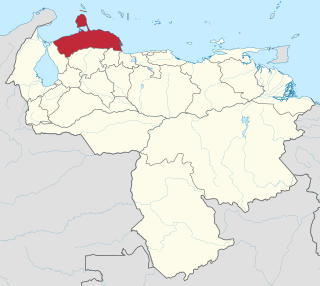
Falcón State is one of the 23 states of Venezuela. The state capital is Coro.
Jinotega is the capital city of the Department of Jinotega in north-central Nicaragua.
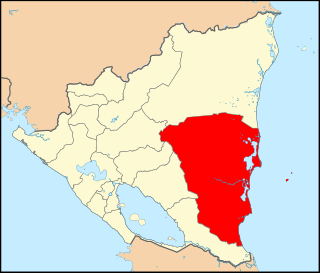
The South Caribbean Coast Autonomous Region is one of two autonomous regions in Nicaragua. It was created along with the North Caribbean Coast Autonomous Region by the Autonomy Statute of 7 September 1987 through a division of the former Zelaya Department. It covers an area of 27,260 km2 (10,530 sq mi) and has a population of 420,935. The capital is Bluefields. Bordering the Caribbean Sea, it contains part of the region known as Mosquitia.

Protección is a municipality in the Honduran department of Santa Bárbara.
Nuevo Edén de San Juan is a municipality in the San Miguel department of El Salvador.

Chichigalpa o Chichicapan (nahuat) is a town and municipality in the Chinandega Department of Nicaragua.
La Libertad is a municipality in the Chontales Department of Nicaragua. It is the birthplace of President Daniel Ortega, Cardinal Miguel Obando y Bravo, and Vice President Omar Halleslevens. It has a population of 14,712 people.

Tipitapa is a city and municipality in the Managua department of western Nicaragua. The area is located between Lake Managua and Lake Nicaragua.

Nueva Guinea is a town and a municipality in the South Caribbean Coast Autonomous Region of Nicaragua.
Paiwas is a municipality in the South Caribbean Coast Autonomous Region of Nicaragua. The administrative center is the town of Bocana de Paiwas.
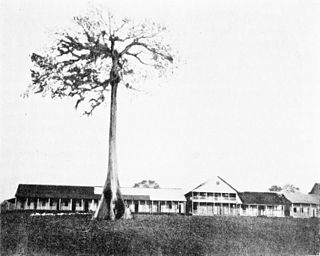
Rama is a municipality and a city in the South Caribbean Coast Autonomous Region of Nicaragua.
El Tortuguero is a municipality in the South Caribbean Coast Autonomous Region of Nicaragua. It is located at about 530 km from Managua and can only be reached by an hour-long truck ride from El Rama.
Muelle de los Bueyes is a town and a municipality in the South Caribbean Coast Autonomous Region of Nicaragua.
The Democratic Revolutionary Alliance were the Southern Front guerrillas in Nicaragua that fought against the Marxist–Leninist elements of the original Sandinista that took part in the Nicaraguan Revolution of 1979. Despite being one of the Contra forces, they maintained an ideological distance from the U.S.-backed Nicaraguan Democratic Force (Contras).

Almoloya de Juárez is a town in the State of Mexico and the seat of the municipality of Almoloya de Juárez. The name Almoloya comes from the Nahuatl, that is properly Almoloyan, composed of: atl, "water"; molo "impersonal voice of moloni, to flow the source" and yan, "place"; that it means "place where flows the water source".
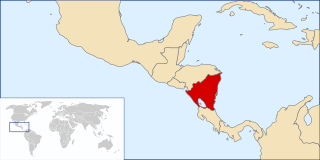
The following is an alphabetical list of topics related to Nicaragua.
Volcán is a town and corregimiento in Tierras Altas District, Chiriquí Province, Panama. It has a land area of 233.7 square kilometres (90.2 sq mi) and had a population of 12,717 as of 2010, giving it a population density of 54.4 inhabitants per square kilometre (141/sq mi). Its population as of 1990 was 7,146; its population as of 2000 was 10,188.

Tenango del Aire is a municipality located in the southeast portion of the State of Mexico and is about 42 km southeast of Mexico City. The municipal seat is the town of Tenango del Aire. The municipality is bordered by Temamatla, Tlalmanalco, Juchitepec, and Ayapango. Despite the fact that this municipality is distinctly rural, it falls within the Mexico City Metropolitan Area. The name “Tenango del Aire” came about in two parts. Originally and until 1890, the town was known as Tenango de Topopula. “Tenango” means “walled in” or “fenced by stones.” The second part is due to visits by President Porfirio Diaz, who commented on the winds that are prevalent here. “del Aire” means “of the air.”
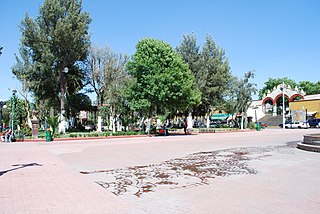
Otumba is a municipality in the State of Mexico in Mexico. The municipal seat and largest town is Otumba de Gómez Farías. The municipality of Otumba has a land area of some 143.42 square kilometres (55 sq mi), and a population recorded in the intermedial 2005 census, the Conteo de Población y Vivienda, of 29,873.













